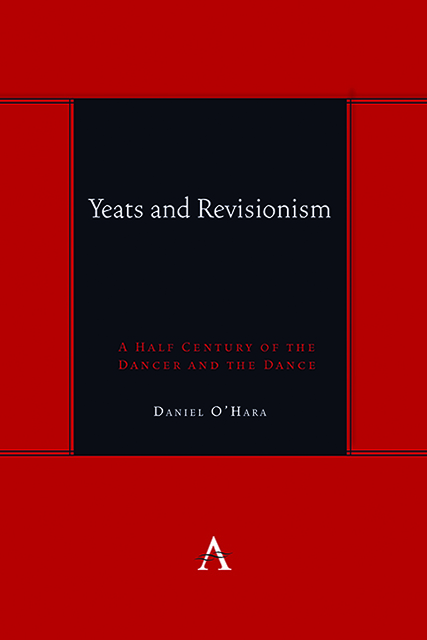Book contents
- Frontmatter
- Dedication
- Contents
- Acknowledgments
- Preface
- Introduction: Dancer and Dance: Yeats’s Romantic Modernism and Critical Revisionism
- Chapter 1 The Irony of Tradition in W.B. Yeats’s Autobiography: Dialectical Hermeneutics Beyond the New Criticism
- Chapter 2 The Specialty of Self-Victimization: On Antithetical Revisionism
- Chapter 3 Yeats in Theory: Blackmur, Bloom, De Man and Hartman
- Chapter 4 The Divisions of Yeats Studies Continued
- Chapter 5 Modernism’s Global Identity: on the Dogmatic Imagination in Yeats, Freud and Beyond
- Chapter 6 Yeats With Lacan: Toward the Real Modernism
- Chapter 7 The Spirit Medium: Yeats, Quantum Visions and Recent Lacanian Studies
- Chapter 8 And All the Ceremonies to Come: Of High Modernism, Visionary Violence and Post-Marxism
- Afterword: The Reader in Yeats
- Bibliography
- Index
Afterword: The Reader in Yeats
Published online by Cambridge University Press: 08 June 2023
- Frontmatter
- Dedication
- Contents
- Acknowledgments
- Preface
- Introduction: Dancer and Dance: Yeats’s Romantic Modernism and Critical Revisionism
- Chapter 1 The Irony of Tradition in W.B. Yeats’s Autobiography: Dialectical Hermeneutics Beyond the New Criticism
- Chapter 2 The Specialty of Self-Victimization: On Antithetical Revisionism
- Chapter 3 Yeats in Theory: Blackmur, Bloom, De Man and Hartman
- Chapter 4 The Divisions of Yeats Studies Continued
- Chapter 5 Modernism’s Global Identity: on the Dogmatic Imagination in Yeats, Freud and Beyond
- Chapter 6 Yeats With Lacan: Toward the Real Modernism
- Chapter 7 The Spirit Medium: Yeats, Quantum Visions and Recent Lacanian Studies
- Chapter 8 And All the Ceremonies to Come: Of High Modernism, Visionary Violence and Post-Marxism
- Afterword: The Reader in Yeats
- Bibliography
- Index
Summary
Two images or scenes of reading in Yeats’ work haunt me. The first occurs at the conclusion of Ego Dominus Tuus, the poem that Yeats attached to the end of his meditation upon visionary creativity, Per Amica Silentia Luna (1918). Basically, for Yeats, visionary creativity happens to the poet, to him, when an occult experience arises, and he becomes the medium of a long-dead person or of a daimon or daemon—a sort of demi-god, located in ancient hierarchy of beings between the human and the fully divine. The torturous self-divisions of life produce a crisis, which the coming of the ghost or daemon (to simplify things), whose wisdom, if properly evoked by the poet will not so much finally resolve the divisions but instead create a bulwark, what Yeats terms the Mask, a symbolic representation of provisional, ritually evoked unity of being. At the end of this poem, we find the following:
Because I seek an image, not a book.
Those men that in their writings are most wise
Own nothing but their blind, stupefied hearts.
I call to the mysterious one who yet
Shall walk the wet sands by the edge of the stream
And look most like me, being indeed my double,
And prove of all imaginable things
The most unlike, being my anti-self,
And standing by these characters disclose
All that I seek; and whisper it as though
He were afraid the birds, who cry aloud
Their momentary cries before it is dawn,
Would carry it away to blasphemous men.
Insofar as a student of Yeats, his scholar–critic–teacher, reads him, he or she fulfills this prayer/prophecy, for Yeats, as he sees it.
The other scene of reading, twenty years later, concludes the poem Lapis Lazuli (1938):
Two Chinamen, behind them a third,
Are carved in Lapis Lazuli,
Over them flies a long-legged bird
A symbol of longevity;
The third, doubtless a serving-man,
Carries a musical instrument.
Every discolouration of the stone,
Every accidental crack or dent
Seems a water-course or an avalanche,
Or lofty slope where it still snows
Though doubtless plum or cherry-branch
Sweetens the little half-way house
Those Chinamen climb towards, and I
Delight to imagine them seated there;
There, on the mountain and the sky,
On all the tragic scene they stare.
One asks for mournful melodies;
Accomplished fingers begin to play.
Their eyes mid many wrinkles, their eyes,
- Type
- Chapter
- Information
- Yeats and RevisionismA Half Century of the Dancer and the Dance, pp. 153 - 154Publisher: Anthem PressPrint publication year: 2022



